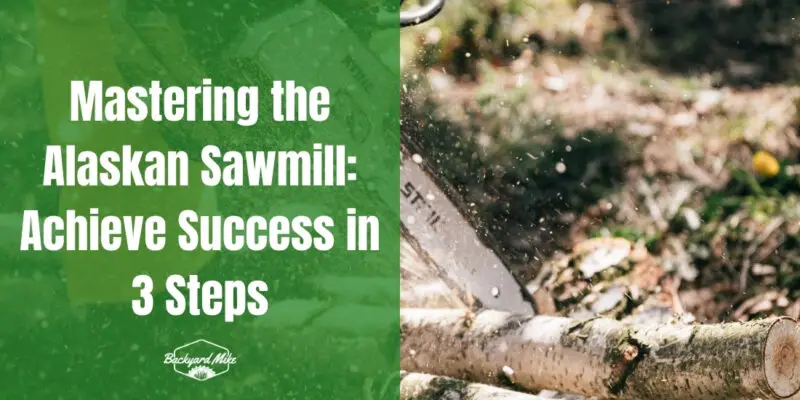To master the Alaskan sawmill and achieve success, start by choosing the right equipment. Opt for a chainsaw with at least 50cc for smaller mills and consider bar length and type. Next, focus on setting up your sawmill precisely. Proper alignment and stability are key, so guarantee all components are square and securely mounted. Finally, when making your first cut, secure the log and guide rails well. Follow these steps for a successful milling journey and discover more techniques ahead.
Key Takeaways
- Select a chainsaw with the appropriate cc and bar length for your mill size.
- Ensure precise alignment and secure mounting of the sawmill for stable operation.
- Position logs correctly and use felling wedges to prevent rolling and pinching.
- Adjust sawmill height for desired slab thickness and use a ripping chain for smooth cuts.
- Regularly inspect equipment, maintain cleanliness, and wear safety gear to ensure safe milling.
Choosing the Right Equipment
When choosing the right equipment for mastering the Alaskan sawmill, start by selecting an appropriate chainsaw that meets your power needs. Opt for a chainsaw with at least 50cc if you're working with smaller mills, but larger mills require a minimum of 60cc for peak performance. Focus on chainsaw selection by considering bar length and type; verify it's at least 2-1/4 inches wide and compatible with ripping chains. Popular brands like Stihl and Husqvarna offer reliability and power, with models such as the Stihl MS880 and Husqvarna 365 being highly recommended. Stihl chainsaws are known for their anti-vibration system, which reduces user fatigue and enhances control during operation. As for mill features, consider Alaskan MKIV models for versatility in handling various log sizes. The Alaskan MKIV Chainsaw Mill offers a range of sizes from 24 to 84 inches, making it ideal for homeowners and professional sawyers alike. Choose a setup that complements your chainsaw, guaranteeing efficient and smooth milling.
Setting Up the Sawmill
Setting up the sawmill begins with mounting it correctly to guarantee a stable and efficient operation. First, verify the sawmill alignment is precise by confirming all components are square. Adjust the bar length so it fits within the mill's requirements, leaving room for sprocket clearance.
Tighten the end brackets to secure the setup firmly on the bar. Use an Allen wrench to evenly secure the handle, preventing movement during use. For ideal stability, align the guide rails properly, ensuring they remain steady as you mill. Wedges are essential for maintaining stability during cuts, as they prevent the log slab from pinching the saw.
Use a ratchet and half-inch drive to tighten grade-five bolts, ensuring equal engagement. Remember, a well-aligned sawmill not only enhances cutting accuracy but also fosters a sense of community among skilled millers.
Making the First Cut
Before making the first cut with your Alaskan sawmill, guarantee the guide rails are securely installed to provide a flat surface for the mill to glide on.
Confirm the log's positioning is stable, ideally with its flattest side facing up to enhance cut quality. Use felling wedges to prevent the log from rolling, confirming log stability.
Ensure the log is stable with its flattest side up, using felling wedges to prevent rolling.
Secure guide rails with lag bolts, placing them wisely so the saw cuts beneath, avoiding damage. Regularly check rail leveling to maintain consistent cuts. Properly drying the freshly cut slabs is essential to prevent warping and splitting, ensuring long-lasting quality.
Adjust the sawmill height to your desired slab thickness, confirming precise and even cuts. Opt for a ripping chain, which aids in achieving a smooth cut.
Maintain an ideal cutting speed and frequently check saw lubrication to prevent overheating, confirming superior cut quality.
Frequently Asked Questions
How Do I Maintain the Chainsaw for Continuous Milling?
To keep your chainsaw ready for continuous milling, regularly sharpen the chain and use proper oiling techniques. You'll prevent overheating and maintain efficiency, ensuring you're part of the community that masters sawmill operations effortlessly.
What Safety Gear Is Recommended While Operating the Sawmill?
Ever thought what protects you in a sawmill? Embrace safety protocols by donning protective equipment like ear muffs, safety glasses, helmets, and steel toe boots. Stay safe, be part of a community that prioritizes well-being and success.
How Should I Store the Sawmill Tools When Not in Use?
You've got to guarantee tool organization by storing them in dry, enclosed spaces like cabinets or toolboxes. Use storage solutions like pegboards for vertical storage, keeping everything categorized for easy access while preventing rust and corrosion.
What Should I Do if the Chainsaw Overheats During Milling?
If your chainsaw overheats during milling, stop immediately. Check for chainsaw cooling issues like inadequate lubrication or dirty cooling fins. Address overheating causes by cleaning and adjusting. You're not alone; every enthusiast faces this challenge.
How Can I Ensure a Stable Footing While Working on Uneven Ground?
You might think leveling techniques are unnecessary, but ensuring ground stability is essential. Use adjustable decking supports for precision and helical piers for secure anchoring. You'll find stability, confidence, and community among those who value safety-first approaches.
Conclusion
You've tackled the Alaskan sawmill with precision, carving your path to success. By choosing the right equipment, you've set the stage for efficient milling. Setting up the sawmill with care guarantees stability and accuracy, making the whole process smoother. Finally, making that first cut, you've transformed raw logs into usable lumber, a feat that once seemed monumental. With these steps, you've mastered the art of milling, turning timber into treasure with skill and confidence.


